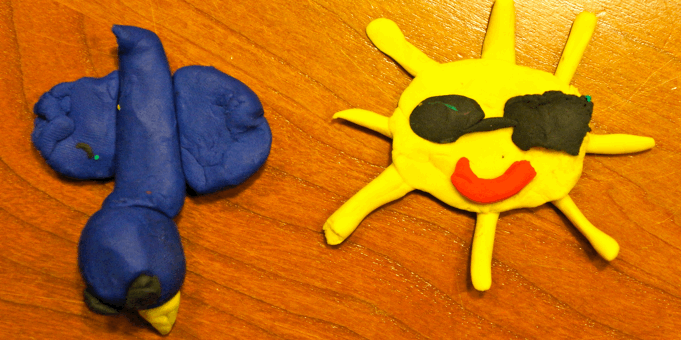Modeling clay is a popular product used in crafting. There are many different clays on the market, but it is important to understand which clays are considered safe, and which are potentially toxic to children and to the environment. Clays that are generally safe for the environment and for kids are oil-based clays, water-based clays and dough clays. Polymer clays are considered toxic and potentially harmful to the environment.
Polymer Clays
Polymer clays contain polyvinyl chloride (PVC), a plastic additive that is popular in clays because of its hardening properties. However, PVC contains the chemical dioxin, a proven carcinogen, and phthalates. Exposure to phthalates has been linked to conditions such as infertility, attention disorders, autism, and cancer. Also, PVC contributes to global plastic pollution when it is discarded or when it gets into our natural environment.
Examples of brands that contain PVC: Sculpey Polymer Clay, Craft Smart Polymer Clay and Fimo Polymer Clay
Oil-Based Clays
Oil-based clays are made of minerals, oils, and waxes, in different combinations and concentrations depending on the brand. Oil-based clays are considered safe for children, and they do not stick to skin or other surfaces that they touch, leaving little to no residue. They also do not air dry, so they can be reused, and these clays are made from naturally found oils, minerals, and waxes.
Examples of oil-based clay brands: Craft Smart Plastalina Modeling Clay, Chavant Prima Plastilina Clay, and Sargent Art Plastilina Modeling Clay
Water-Based Clays
Water-based clays are made from water and clay. They are very smooth and are not very sticky or messy. They are also easy to work with and are inexpensive. Since they contain only a few natural ingredients, they are non-toxic and environmentally friendly.
Examples of water-based brands: Crayola Air Dry Clay, AMACO Magic Mud and Crayola Model Magic
Dough clays
The main ingredients in dough clays are usually flour, cornstarch, cream of tartar, oil, and water. These dough-based clays, referred to as ‘play doughs’, are generally safe for children and for the environment. However, dough-based clays are not safe if your child has a wheat or gluten allergy. Below is a gluten-free alternative for children with wheat or gluten allergies.
Examples of dough clays: Play-doh, Aroma Dough Gluten Free Playdough, and Homemade Play-doh (can be made gluten free!)
Safety tips for working with clay, as well as other art materials:
- Avoid products that don’t have a non-toxic seal from the Art & Creative Materials Institute.
- Read labels and look for labels like recyclable, ethically-sourced, sustainable, natural, low or no VOC, non-toxic, chemical-free, BPA-free, PVC-free, renewable, biodegradable and water-based.
- Dispose of hazardous materials properly.
- Avoid products designed for professional artists.
- When in doubt, choose the liquid form over the powder form, and choose brush-on rather than spray. This doesn’t guarantee it is non-toxic, but it lowers the risk.
- Wear gloves to prevent skin contact.
Gluten Free Modeling Clay Recipe
Ingredients:
- 2 cups salt
- 2/3 cups water
- 1 cup cornstarch
- 1/2 cup cold water
Directions:
- Stir salt and water in a saucepan over heat for 4-5 minutes.
- Remove from heat; add cornstarch and cold water.
- Stir until smooth; return to heat and cook until thick.
- Allow the clay to cool, then shape as desired.
- When dry, decorate with paint, markers, glitter, and so on.
- If you like, finish with clear acrylic spray or clear nail polish (that is all-natural, non-toxic, and biodegradable when possible!)
- Store unused clay in a Ziploc bag
Sources:
https://ecofriendlycrafts.com/blogs/green-crafting/5-toxic-craft-supplies
https://www.fxsupply.com/materials/clay_waterbased.html
https://www.artmolds.com/clay-types
https://www.familyeducation.com/fun/clay/homemade-clay-recipes
By S.J. Naim, a Boston College junior working as an intern for Green Newton during the fall 2021.



Recently on Twitter